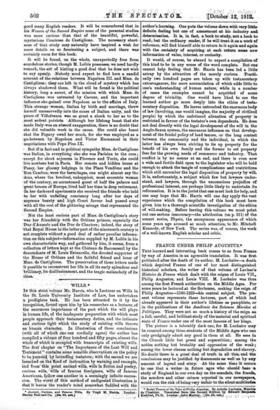MADAME DE cAdrior,,Ion.*
M. Feenketee Lowxa a recent book, excellently translated, as it was certain Co 'be, by Mr. MortOn Fullerton, is sure of a
• thniomance of a Favourite. y {'Ztdfaric.t. ,,....Tessalseet ,by Morton Fullerton. Illustrated. London : Constable and Co. [10s. Cd. net.] good many English readers. It will be remembered that in his Women of the Second Empire none of the personal studies was more curious than that of the beautiful, powerful, mysterious Conitesse de. Castiglione. The necessary short- ness of that study may naturally have inspired a wish for more details on so fascinating a subject, and there was certainly room for this book.
It will be found, on the whole, unexpectedly free from -scandalous stories; though M. Loliee possesses, we need hardly remark, the at of hinting a good deal that he does not wish- to say openly. Nobody need expect to find here a candid account of the relations between Napoleon III. and Mme. de Caatiglionei they are left in the cloud of mystery which has always shadowed them. What will be found is the political history, long a secret, of the mission with which Mme. de --Castiglione was entrusted by Cavour, and the important influence she gained.' over Napoleon as to the affairs of Italy. This strange woman, Italian by birth and marriage, threw herself unreservedly into the cause of Italian unity, and the -peace of Villafranca was as great a shock to her as to the most ardent patriots. Although her lifelong boast that she made Italy was an absurd exaggeration, there is no doubt that she did valuable work in the cause. She could also boast -that the Papacy owed her much, for she was employed as a ''go-between by Napoleon and Victor Emmanuel in their negotiations with Pope Pius IX.
But if in fact and in political sympathy Mme. de Castiglione was Italian, in everything else she was Parisian to the core ; 'except for abort sojourns in Florence and Turin, she could -live nowhere but in Paris. Her remote and hidden house at '-Paasy, her gloomy lodgings in the Place Vendtnne and the Rue Cambon, were the hermitages, one might almost say the dens, where the loveliest, unhappiest, moat eccentric woman of the century, an accustomed guest of half the palaces and great-houses of Europe, lived half her time in deep retirement. -In her darkened apartments she received the friends who held to her with unfailing constancy long after her days of • siipreme beauty and high Court favour bad passed away with all the rest of the glittering mirage that represented the Second Empire.
Not the least curious part of Mme. de Castiglione's story was her friendship with the Orleans princes, especially the Duo d'Aumitie and the Duc de Chartres ; indeed, the story of that Royal House in the latter part of the nineteenth century is not complete without a good deal of rather peculiar informa- tion on this subject—information supplied by M. Loliee in his own charakteristie way, and gathered by him, it seems, from a -collection of letters kept at the Chateau de Baromesnil by the descendants of M. Louis Estancelin, the devoted supporter of the House of Orleans and the faithful friend and lover of Mine. de Castiglione. The preservation of these letters made it possible to reconstruct her life in all its early splendour and bfilliancy, its disillusionment, and the tragic melancholy of its close.











































 Previous page
Previous page